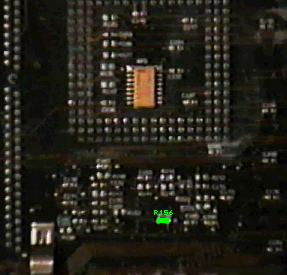
This is a modification that can be performed on a Quadra 630, LC630, Performa 630, Performa 631, Performa 635, Performa 636, Performa 638, or Performa 640 to speed it up to 40MHz.
Keep in mind that this will void your warranty. Dealers or Apple may refuse to accept the board as an exchange in or out of warranty with this modification.
Unlike the modifications outlined in the Mac Crystal Oscillator Speedup History File I maintain where those computers use a TTL crystal oscillator to clock the processor, the Quadra 630 uses a Clock Generator. This clock generator is located at position U20 on the motherboard. Depending on the surface mount resistors used, this part will either put out a signal for 25, 33, or 40MHz operation. Unlike the procedure used to clock chip many of the other Macs, this procedure is not a "sure thing". This is partly because you cannot back off just a little if you have problems at 40MHz. The statistics at the bottom of the page will help you weigh the risks.
There are four resistor pads used in this modification. Surface mount (SMT) resistors are placed in these pads to pull "low" or "high". The resistor pads are in sets of two, so you need to have a resistor on one of the first two and one of the second two. The resistors are either 300 Ohms (301) or 4.7k Ohms (472). They are the "0805" surface mount package.
|
R153 (low) |
R149 (high) |
R155 (low) |
R156 (high) |
Pull |
Speed |
|
301 |
|
301 |
|
low, low |
25MHz |
|
301 |
|
|
472 |
low, high |
33MHz |
|
|
472 |
|
472 |
high, high |
33MHz |
|
|
472 |
301 |
|
high, low |
40MHz |
The Quadra 630, LC630, P630, P635, P636, and P638 use the same motherboard. The LC and Performa machines have a 33MHz 68LC040 processor instead of a full 68040. Unlike the Q605 modification, the gestalt does not change at the different speeds, so there are no software install problems, and there will never be any software install problems on a modified 63x machine in the future.
To do the modification to go from 33 to 40MHz, a 21% speedup, you just need to swap some resistors. The resistors have been glued onto the board prior to soldering, so you need to heat both sides of the SMT resistor at the same time with two soldering irons, and lift the resistor off with the irons. This will break the glue's bond to the SMT resistor. To solder on the resistor, place it on the pads (it does not matter which way it faces), hold it there with a small screw driver, and solder one side to the board at a time.
The modification:
That's it.
Note: there are two versions of this board.The Rev A board is marked 820-0624-A on the top of the board in the corner next to the LC PDS slot, and on the bottom of the board on the opposide side from the SIMM slot. R149, R153, and R155 are on top of the board, and R156 is on the bottom.
The Rev B board is marked 820-0548-B on the top of the board in the corner next to the LC PDS slot, and on the bottom of the board on the opposide side from the SIMM slot. All four resistors are on the bottom of the board.Here are some Rev A motherboard shots thanks to Ross (ross@ctol.net)
Top of the board:




Here's a picture of the bottom of a Q630 board and the location of the resistors for a Rev B board:

And here are two more pictures that might help.



Keep in mind however that the 33MHz 68040 will now be running at 40MHz. The part is not rated to run at these speeds, but my experience shows that this will not be a problem.
You will also want to place a heat sink on the 68040. You have plenty of space, so any of those heatsinks will do. There is no need for an additional fan since the Apple fan blows air right over the processor.
The Valkyrie (video) chip also gets pretty warm, so you should attach a small heatsink to it as well. The one I used was 28 x 26 x 15mm.
Here's a picture of the top of a Q630 board with heatsinks on the 68040 and Valkyrie chips:

There are some Speedometer 4.0 Files for a Q630 at 25, 33, and 40MHz on the Clock Chipping Home Page you may want to check out.
At 25, 33 and 40MHz I have checked the serial ports, video, floppy drive, IDE drives, and RAM, and have observed no problems.
I've now heard of several cases where Apple and Daystar PPC cards worked fine in modified Q630s, so it looks like the PPC card will work fine at 80MHz.
A question has been raised as to the success of this modification. If you perform this modification on a 630, please fill out this form (or e-mail me if your www browser does not support forms) and let me know if you have any video problems. I would also like to know if you have placed a heatsink on the 68040, and the Valkyrie chip. Your name will not be logged unless you input it, but it might be useful for me if I have questions for you.
(Please come back and fill in the form after you do the modification so we can get some statistics)
|
Heatsinks |
Video Okay |
Video Problems |
|
None |
166 |
24 |
|
68040 |
91 |
13 |
|
Valkyrie |
3 |
3 |
|
Both |
103 |
21 |
Marc Schrier
schrier@mac.com